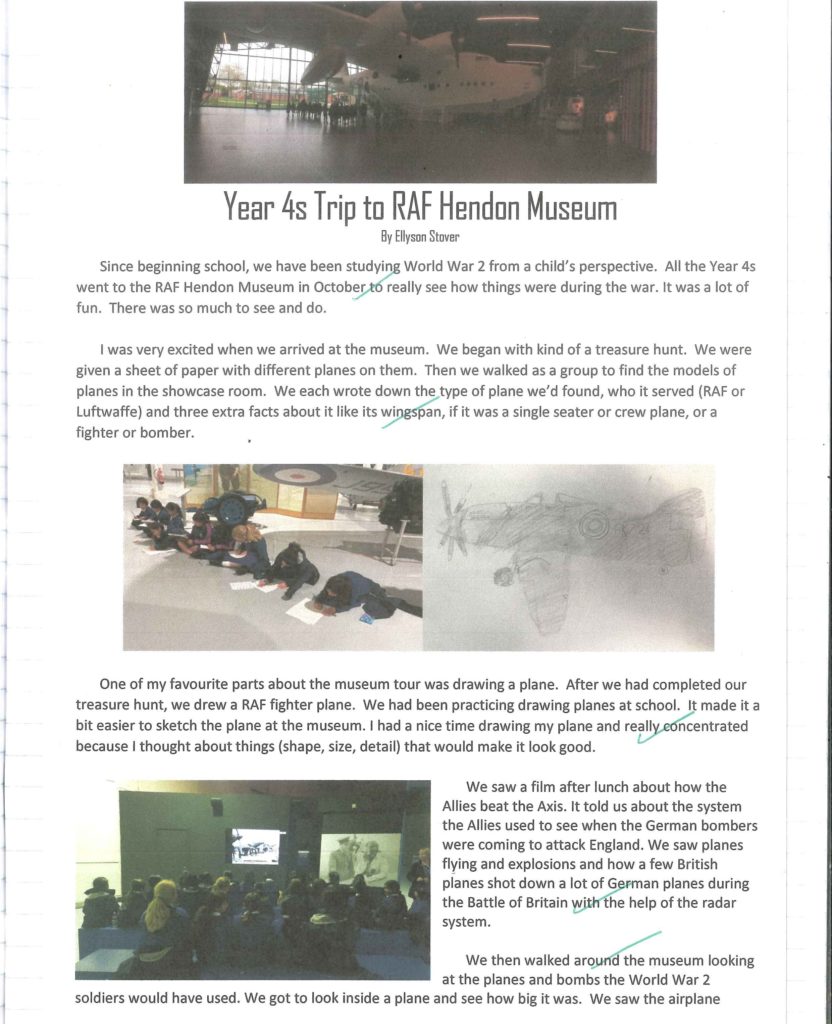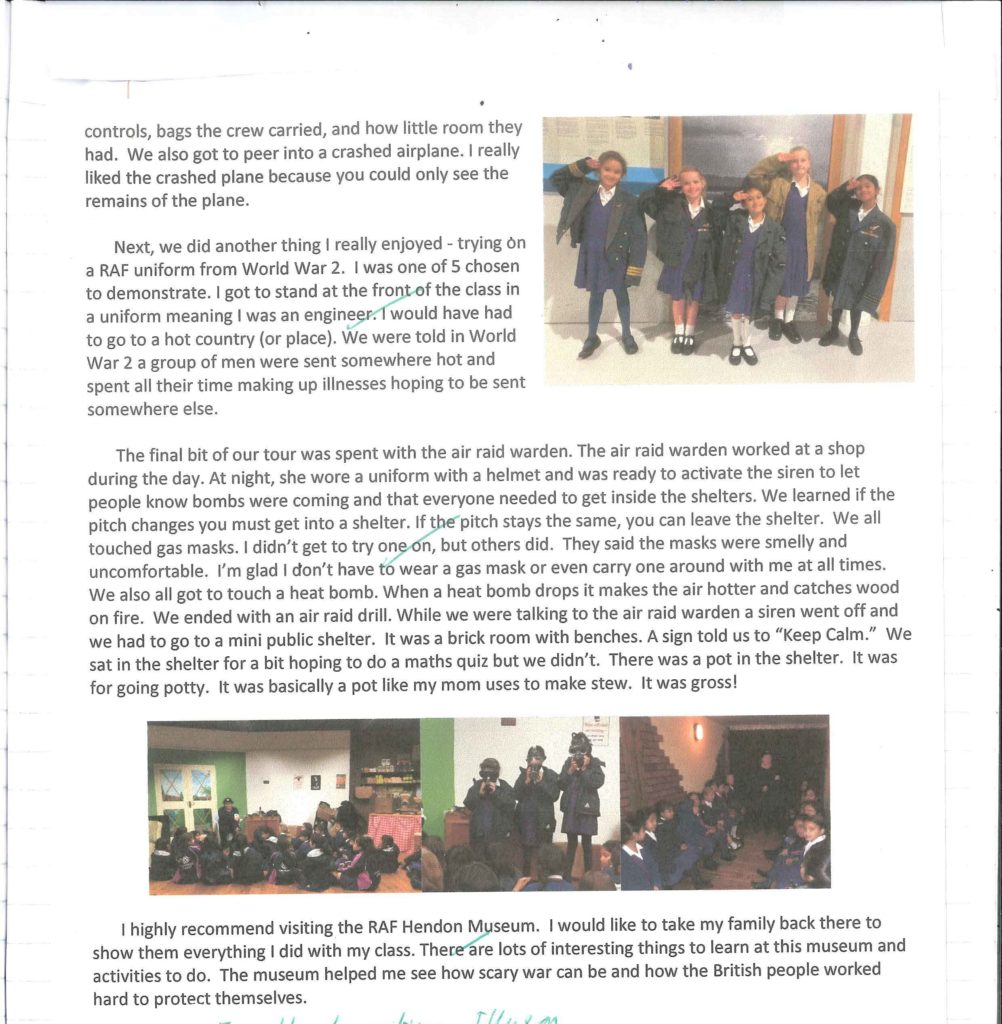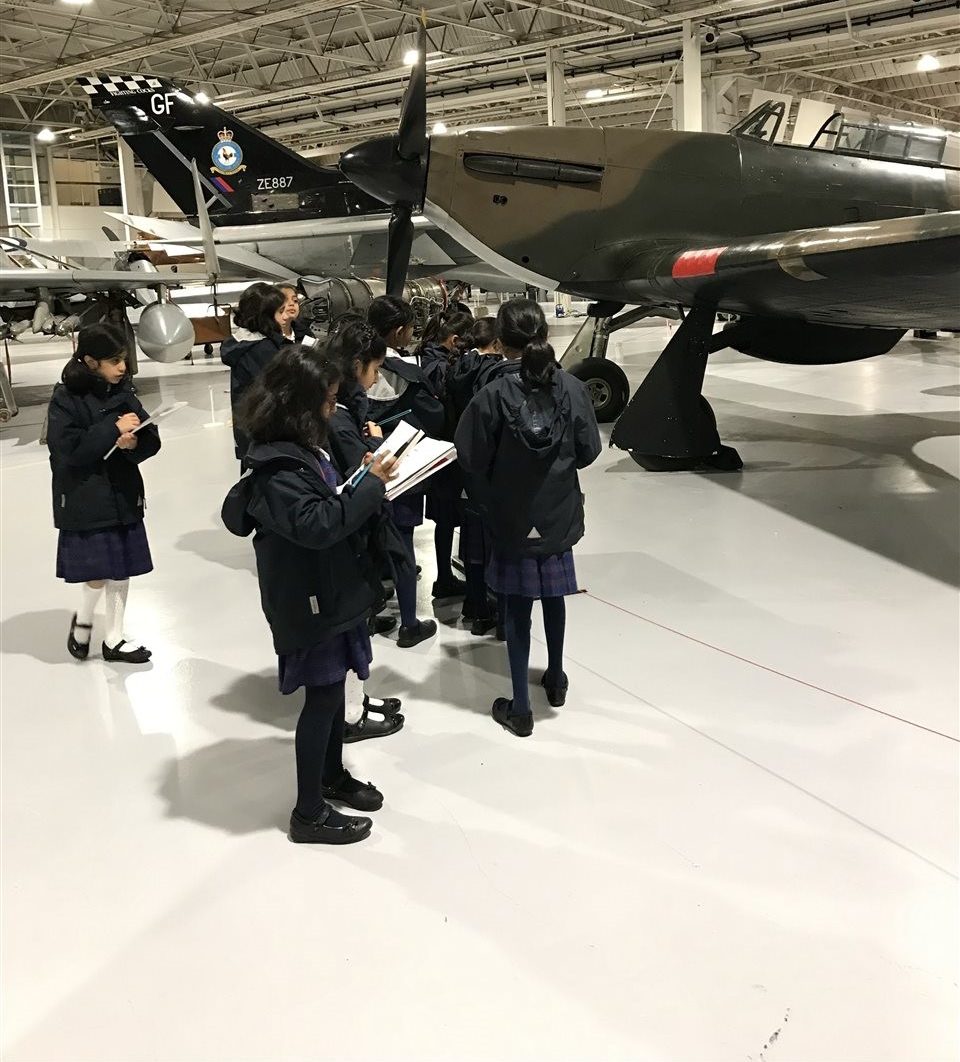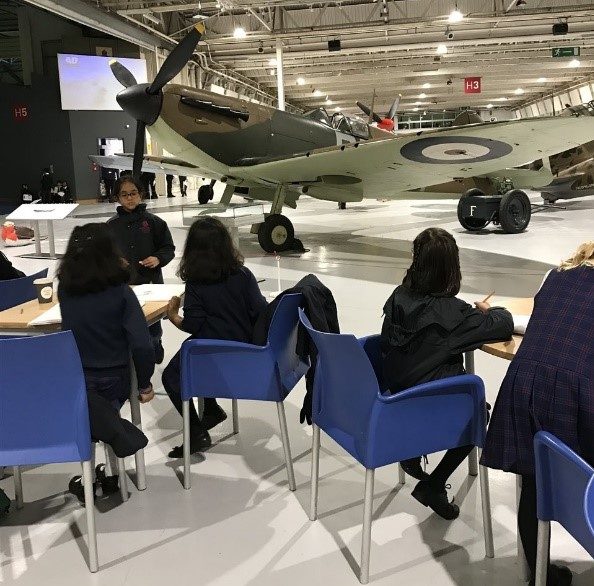Year 4 Trip to Hendon
On Friday 11 October, Year 4 embarked on the RAF Museum in Hendon to enrich their understanding of World War II. The girls enjoyed a World War II aircraft hunt and discovered the variety of planes flown by the RAF. They put their artistic skills to good practice as they were tasked to sketch a World War II aeroplane in the main hangar. Even though challenging, the girls were undaunted by the task. Observing the shapes of the planes carefully, the girls sketched accurately. It was a pleasure to hear the comments of other museum visitors praising the girls’ behaviour and focus during this activity.
A workshop, run by the enthusiastic RAF Museum staff, explored artefacts commonly found during the war. The girls were also given the chance to experience a mock air raid which was terribly exciting!
After returning to school, the girls wrote a recount about their visit. One recount from each of the Year 4 classes has been selected to give you a detailed look into their experience of the visit….
Well done Ellyson, Maya and Ananya, Year 4.
Recount: Day trip to RAF Hendon by Ananya S, Year 4
On Friday, 11 October 2019 our class visited the Royal Air Force museum in Hendon. As we have been learning about World War II as our topic in school, this trip was to help us understand the importance of aircrafts in the war.
On the day of the trip, Mrs. Talbot briefed us on the schedule for the day and divided us into smaller groups of 5 to 6 students. There was a lot of hustle and bustle as we got on to the coach. Although it was pouring heavily with dark clouds across the sky, the mood inside the coach was the complete opposite. We always look forward to our school trips, but we were especially excited for this one as we could spend £5 at the RAF Hendon shop. The coach trip took approximately 45 min.
Once we reached RAF Hendon, a RAF representative escorted us into a huge white building with a metal roof. While walking towards the cages to store our lunch, we saw a lot of planes. I was particularly fascinated by the Curtiss Kittyhawk, a plane with a shark’s mouth painted on its nose. While we ate our snacks on the wooden tables near the cages, our teachers handed out A4 sized charts for our first activity. The chart had four columns – the first column contained pictures of aeroplanes and their names and the other three were left blank for us to complete. We had to write the air force it belonged to (RAF, Luftwaffe or American air force) in the second column, the type of the aeroplane (Fighter, bomber, trainer or passenger) in the third and three other important facts (for example, when it was used, its top speed and its first mission) in the fourth.
After finishing our snacks, we got into our groups and started exploring the planes stationed in the hangars to gather information for the activity. It took us a long time to locate the planes but once we found them, it was quicker to note down the facts as all the information was displayed in front of each plane. I was quite thrilled to discover facts about aeroplanes that I never knew about. Subsequently, we had our lunch break in an aeroplane shaped area.
Shortly after lunch, we had a workshop with a cheerful lady called Tony. I was looking forward to this as workshops are normally my favourite part of a school trip.
During the workshop, Tony pretended to be an ARP warden and I found her explanations on air raid precautions very descriptive. They included information on how signals were used to instruct people to put on gas masks. As she was explaining about air raid sirens, one unexpectedly went off! We were hurried into an Anderson shelter and she asked us to find things to do as it could be a long time before we could get out. We were all relieved as the all-clear sounded moments later.
Then she took us downstairs and showed us navy blue World War II uniforms and what the letters on the badges meant. We even got to pose for a class photo in those uniforms!
Then came the activity we were all most excited about. We were led by our teachers to the RAF Hendon souvenir shop. As it was our first independent shopping experience, the teachers gave us useful instructions on things to buy. The shop was filled with pens with bubbles inside, notepads with RAF symbols, small hand-held torches, red arrow slap bands, small spitfire shaped badges and many more fascinating things. We all started scanning the shop and had tough decisions to make as we had only £5 to spend.
Soon it was time for the last activity in the schedule. We came to another area and sat down at the wooden tables placed around a large plane. We started drawing the plane in our Art and DT books. Mrs. Talbot encouraged us to draw the plane from the angle we could see it from. I found this a challenging task.
After we completed this task, we reluctantly left RAF Hendon and got on to the coach. It was a long ride back and even though I felt tired, I would come back to visit any time as it was a fun-filled and rewarding experience. I really enjoyed learning about different types of planes and how they were used in World war II.
Maya Chotulal, Year 4
It was Friday 11 October the day of our school trip to RAF Hendon. I hardly slept the night before; I was so excited!
Miss Willis took our register and briefed us on the day’s activities first thing in the morning, around 08:45. We were then put into teacher groups in our classroom and then we had to choose a partner from our group who we would be paired with for the rest of the day. My partner was Ines and my group teacher was Mrs Smith. The coach was due to depart at 09:00 and we left on time. The journey took approximately 45 minutes; it was rainy and wet all the way.
When we arrived, we got into our groups again and headed inside. The teachers took us in and we met an RAF Hendon tour guide. We went to an area where we could leave our lunches, it was a big metal cage. Some of us were hungry and started snacking so we all sat down and ate our snacks.
Immediately after eating, everyone was given an activity sheet. On the activity sheet there were lots of different planes from WW2 and we had to find them in the museum. We had to identify if they were British or German fighter or bomber planes. British planes belong to the Royal Air Force (RAF) which had the RAF symbol, blue white and red circles and the German (also known as the Luftwaffe) planes had a Black and White cross or the Swastika. The Swastika was the German Nazi symbol used on their flags and uniforms. It was an interesting fact find. When we finished we handed our sheets back to our teachers.
Finally, lunch time. I was so hungry my tummy was rumbling! We headed back to our break area where we collected our lunches and sat down to eat. While I was eating, a little boy, maybe 2 years old, came over and took a crisp out of my hand, we all found it very funny. His mum came over and apologised but I said it was fine. During lunch we talked about the planes we had just seen. It was very exciting to be able to see them in real life.
After lunch, we went back into our groups and we went around the museum to find a plane we liked. Our group chose a British fighter plane called the Spitfire, one of the most famous RAF fighter planes of the War. We were then given our art books from the teacher so we could draw that plane.
Then we went upstairs with a museum guide and she took us back in time to WWII! It was interesting and scary. We learnt that men over 18 had to fight in the war and ladies usually helped in the farms, at home and also trained to be nurses. During the Blitz (an intense period of bombing) people had to put up black outs in their windows so that the German bombers didn’t know where to attack as there was no light. Adults and children had to wear gas masks so they could breathe clean air if a bomb was dropped. We also experienced an air raid siren which was loud. In the war it would have been really loud so everyone could hear it and get into their shelters. I felt really upset for people who died and people who had to sacrifice their life for their country. It must have been a horrible time to live.
Later, we went downstairs and another museum guide explained to us the different types of jobs people had in the RAF like Pilots, Engineers, Air Gunners and a few others. We got to see some of the uniforms that they would have worn! They had different badges and stripes on the jacket front, sleeve and cuffs. They each represented how important you were and what your job was. We were lucky enough to try some of these jackets on. My jacket had an E printed in a wing which meant it would have been worn by an RAF Engineer!
At the end of the day we visited the RAF museum shop where we were allowed to buy something for ourselves or for someone else if we wanted to. I bought an RAF pen for my mum and dad, an RAF pencil for my sister and lip balm for myself.
Conclusion
I really enjoyed the day and my visit to RAF Hendon. I learnt so much about the war and the sacrifices people made for their country. It was upsetting to hear about these things and I hope we never have to go through this again.
The museum helped us to bring these things to life. It was great to be able to see the planes and experience what it might have been like to live during the war.
It was lovely spending time with my friends, working on activities and being together outside of school.
Overall it was a wonderful and memorable experience which I would thoroughly recommend. It’s great for adults and children.






